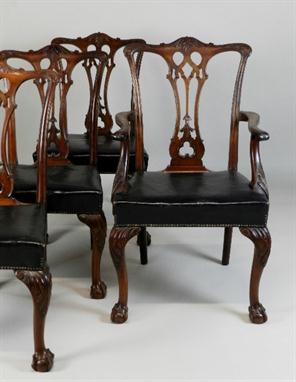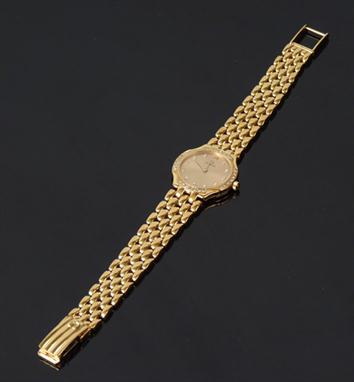Four Lesney Matchbox boxed models: 26 Cement Lorry (VG in VG box); 9 Merryweather with silver ladder (G/VG in G/VG box with small tear to end flap); 61 Alvis Stalwart (G in F box); 24 Rolls Royce (G in P box). Together with two 74b Daimler Buses in green (one with `Visco-Static` to one side, the other `Greyhound` to one side), both VG unboxed, and a Routemaster with `Dewar`s` on one side, P unboxed. (7)
We found 31159 price guide item(s) matching your search
There are 31159 lots that match your search criteria. Subscribe now to get instant access to the full price guide service.
Click here to subscribe- List
- Grid
-
31159 item(s)/page
A pair of painted rush seat ladder back chairs in the Dragon Furniture manner, one inscribed with quote "Never to be forgotten that first long secret drink of golden fire, juice of those valleys and of that time wine of wild orchards or russet summer of plump red apples and Rosie`s burning cheeks never to be forgotten or ever tasted again" by Laurie Lee, the other decorated with seashells, together with a modern painted wrought iron towel rail of scrollwork form and a turned beech and copper wash dolly
DODGSON C. L.: (1832-1898) Lewis Carroll. English Author of Alice`s Adventures in Wonderland. An excellent A.L.S., C L Dodgson, four pages, 8vo, Christ Church, Oxford, 13th May 1879, to [Thomas Gibson] Bowles. Dodgson announces `I much admire your shower of hard words, & have sent it on to the printer, though without the least expectation that it will calm the storm, or do anything to diminish the general feeling of discontent which I see settling down upon all who have taken up "Doublets"` and continues `May I, without giving offence, venture on a word of remonstrance as to the last "Hard Case"? (I mean the one about a son "born before wedlock"). I cannot consider such a subject as fit for discussion in a drawing room, & among young ladies-& surely that is the sort of society among which you intend the paper to circulate? At any rate that was my impression when I presented you with "Doublets".` Dodgson expands further, `Please do not think me officious: I don`t think I should venture to trouble you, only that I feel that I am now personally connected with V.F. and concerned in its reputation. I have been recommending my young lady friends, right & left, to take up "Doublets", & I confess it comes on me rather as a shock to find that the same paper invites them to discuss a question of bastardy.` He concludes the letter `Don`t (I earnestly beg of you) make me repent that I ever let my name appear in the columns of V.F.` before adding a postscript, `Lest I should be misunderstood, I add that I don`t consider the "Hard Case" as objectionable in itself. As between man & man, I would have no objection whatever to discuss such a question. I simply plead on behalf of the young ladies-& I know of many who are now looking to the "Doublets" with keen interest...` Some very slight, minor show through of Dodgson`s characteristic purple ink, largely to the upper half of the pages, VG Thomas Gibson Bowles (1841-1922) Founder of the magazines The Lady and Vanity Fair. Maternal Grandfather of the Mitford sisters. Dodgson`s preoccupation with the subject of Bastardy within Vanity Fair is interesting-Bowles himself was the illegitimate offspring of politician Thomas Milner Gibson and a servant girl, Susannah Bowles. Doublets, also known as Word Ladder or Word Golf, is a word game which Dodgson invented on Christmas Day in 1877, although the first reference to it in his diaries appears on 12th March 1878. Vanity Fair published the first of Dodgson`s Doublets in their 29th March 1879 issue.
A set of seven Victorian mahogany Chippendale style dining chairs including one carver, the leaf carved top rail over a pierced vase shaped back splat above a studded over-stuffed seat on cabriole front legs terminating in a ball and claw foot, along with a matched Chippendale style pierced wavy ladder back carver chair on square chamfered legs united by a plain H stretcher (8)
CRUIKSHANK. The Scourge; or Literary, Theatrical and Miscellaneous Magazine. Volume X, London 1815, 8vo, added tipped-in signature of George Cruikshank dated 1866 before title, illustrated with 7 hand coloured folding caricature plates, bound with Fox`s Martyrs, 3rd ed, 1784; The Queen`s Matrimonial Ladder, 1820; The Man in the Moon, 1820, etc., half calf rubbed
A .577 TWO BAND SNIDER-ENFIELD CARBINE, DATED 1864; A .700 CALIBRE CONTINENTAL BREECH-LOADING MUSKET, MID-19TH CENTURY; AND A 20 BORE PERCUSSION MUSKET, 19TH CENTURY the first with sighted barrel, stamped with Ordnance marks and fitted with ladder back-sight, dated lock with Enfield arsenal inscription, walnut stock and regulation brass mounts; the second with sighted barrel, walnut full stock and regulation steel mounts (pitted); and the third for native use (extensively worn) the first: 55cm; 21 3/4in barrel (3)
A ladies Art Deco diamond set Cyma Cymaflex cocktail watch, A circular silvered dial with silver hands and batons. Eight cut diamonds grain set to the bezel, with knot lugs and crossover two row bracelet, all grain set with eight cut diamonds. A later 9ct white gold Brazilian snake bracelet fitted with ladder snap clasp, Birmingham 1959. The case marked ‘PLATINUM LONDON MAKE’. The movement signed ‘Switzerland Tavannes R.433 Cyma’. Case no. 8843 1665
An Enfield Pimlico .577 Percussion Cap Two Band Carbine, the 68cm steel barrel with hinged ladder rear sight, the lock plate stamped with a crown, the walnut full stock with brass trigger guard and butt plate, the tang engraved V LD.1 229, the butt stamped with garter strap enclosing PIMLICO crown, broad arrow W? and 22
A Snider-Enfield Model 1861 Mk.II* .577 Calibre Three Band Musket, the 90cm steel barrel with hinged ladder rear sight, the lock plate engraved with crowned VR cypher 1863 ENFIELD and crowned arrow, walnut full stock with brass fore-end tip, trigger guard and butt plate, the butt stamped in a circle RM Enfield over 1, with one steel sling swivel and steel ramrod
A Swedish Rolling Block Cavalry Carbine, obsolete 12mm calibre, the 46cm steel barrel with hinged ladder rear sight, the receiver stamped with crowned C and dated 1877, with saddle bar and ring, all metal parts numbered 5, walnut full stock, the butt missing brass disc, with black hard plastic case
A 19th Century Robert`s Patent Breech Loading Rifle, the 79cm steel barrel with hinged ladder rear sight, the left side of the receiver stamped ROBERT`S PAT. JUNE.11 1897, the walnut two band full stock with brass fore-end tip, trigger guard and butt plate, the left side of the action stamped 4510 (split), with steel sling swivels and cleaning rod
An 1861 Snider Enfield Mk.II** Rifle, the 93cm steel barrel with hinged ladder rear sight, the breech block stamped II** Snider Patent, the lock plate with crowned VR cypher 1861 ENFIELD and with crowned arrowhead, with nipple cover and chain, walnut three band stock with brass furniture, steel sling swivels and cleaning rod
The impressive and exceedingly rare Second World War Triple D.S.O. group of orders, medals and decorations to Lieutenant-General Sir Harold Rawdon Briggs, K.C.I.E., K.B.E., C.B., D.S.O. and Two Bars; Indian Army, Commander of the 5th Indian Division in the Western Desert, Iraq and Burma (1942-44), G.O.C-in-C. Burma Command (1946-48), and finally Director of Operations, Federation of Malaya (1950-51); comprising: K.C.I.E. Star and Neck Badge, K.B.E. Star and Neck Badge, C.B. Neck Badge, GVIR Distinguished Service Order and Two Bars, 1914-15 Star (2-LT H.R. Briggs. 31 Punjabis), 1914-18 War Medal and Victory Medal with oak leaves (Capt. H.R. Briggs), GVR India General Service with clasp for North West Frontier 1930-31, 1939-45 Star, Africa Star, Burma Star, Defence Medal, 1939-45 War Medal with oak leaf, Indian Independence Medal; and with a mounted set of corresponding miniatures. The lot is offered together with the recipient`s collection of highly important photographs, documents and other ephemera r lating to his campaigns in Africa and in Burma, and including: an album, `The Western Desert 1940-1945`, containing the recipient`s own account of the campaign together with photographs of troops, artillery, transports, P.O.W.s, and senior officers (including the recipient); newscuttings; and the recipient`s warrant for his D.S.O. of December 1941; a similar album `Burma Campaign 1943-44` with further very good photographs, maps, handwritten accounts of the campaigning, correspondence, the warrants for the recipient`s C.B.E., K.C.I.E. and C.B., his Commission from George VI to Governor of Burma; and a small collection of ribbon bars and insignia. The Miniature group includes G.S.M. with clasp for Malaya, which is not present with the full sized medals. Harold Rawdon Briggs attended the Royal Military Academy at Sandhurst before being commissioned into the Kings Regiment (Liverpool) in 1915. After seeing action in France, he transferred to the Indian Army in 1916 and fought in Mesopotamia and Palestine, becoming a company commander in the 31st, and later the 152nd Punjabis. He then transferred to the 10th Baluch Regiment and saw active service in the North West frontier region. At the outbreak of World War Two he was a Lieutenant Colonel in command of the 2nd Battalion 10th Baluch Regiment, and in 1940 he was made Brigadier and given command of the 7th Indian Infantry Brigade. After an initial deployment to the Western Desert, Briggs was sent to East Africa where he commanded `Briggsforce` in action in Eritrea, and was awarded his first D.S.O. Returning to the Western Desert, Briggs took part in various actions including Operation Crusader and the Battle of Gazala, and was promoted to command the 5th Indian Division. For his leadership during this period he was awarded his second D.S.O. 5th Indian Division was then deployed to Burma (via Iraq), where it distinguished itself in various actions, and Briggs was awarded his third D.S.O. Following the war he served as C-in-C Burma command, and in 1948 (the year in which the order was discontinued) he was made Knight Commander of the Order of the Indian Empire. In 1950 he was recalled to active duty as Director of Operations in Malaya, where his `Briggs Plan` was considered a key element in the resolution of the Malayan Emergency. Of this highly successful and distinguished officer, Field Marshall Slim said "I know of few commanders who made as many immediate and critical decisions on every step of the ladder of promotion, and I know of none who made so few mistakes".
-
31159 item(s)/page



![MARC CHAGALL [FRENCH/RUSSIAN 1887-1985], HAND COLORED ETCHING FROM "LA BIBLE", `58, 11 1/2" X 9 1/2": &qu](http://lot-images.atgmedia.com/SR/33875/2864007/2031-2012625131536_468x382.jpg)












































